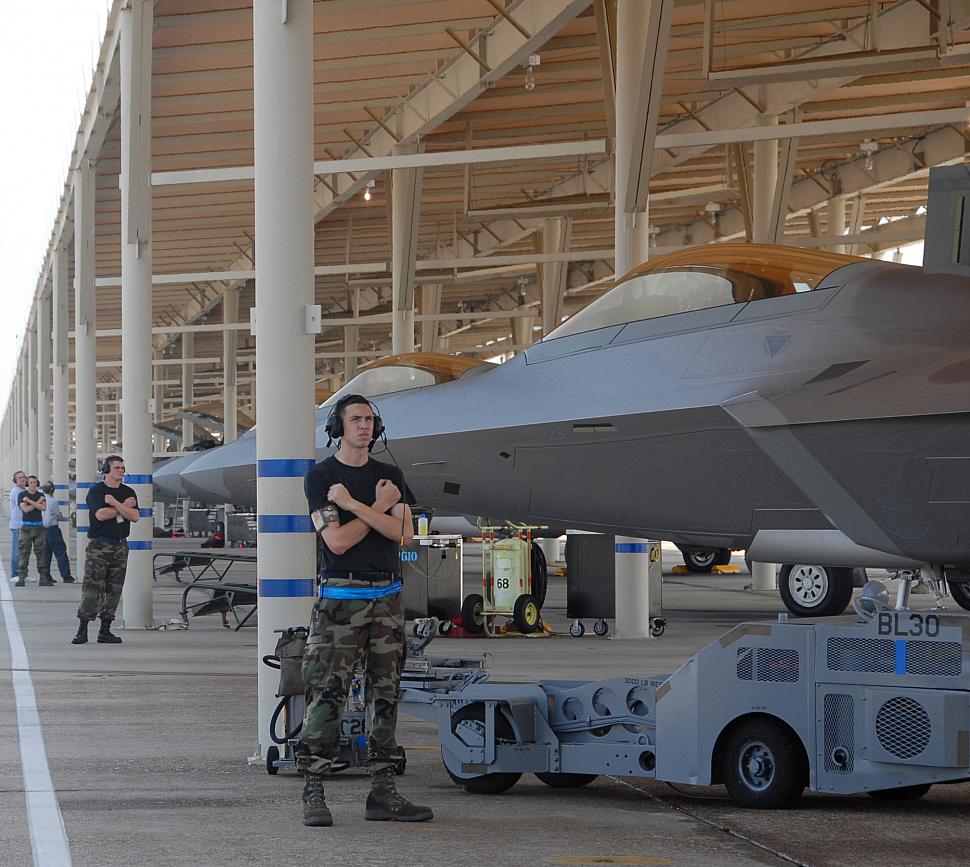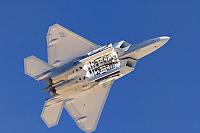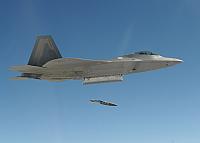Fighter Jet News
F-22 Raptor News
Attacking the F-22 with Yellow Journalism
July 13, 2009 (by
Eric L. Palmer) -
Is it fair to criticize high dollar weapons systems? Yes, if you can tell the story correctly. In the case of the F-22, some news sources have to resort to yellow journalism in order to sell headlines.

Recently an article in the Washington Post made a big splash against the F-22 using deception, gross misstatements and innuendo. It was a big hit. Many gobbled up the nonsense wholesale. What was wrong with it? While it made some good points—the defense establishment rarely has a handle on figuring out big dollar programs—it went over the top by stating some things that just were not true.
For instance, it portrays the F-22 as a maintenance pig. The Post stated that maintenance on the F-22 was getting more expensive and troublesome with time when in fact the opposite is true.
What the Post really missed is that maintenance USAF wide is having challenges and not just one specific airframe. In the past several years with shortages of funds for just about everything, even simple to maintain F-16s have lost up to 10 percent of their mission capable (MC) rates. If one is going to only criticize one USAF airframe they are missing the big picture. Almost all USAF airframes have gone down in MC rates and not just due to age.
Just a few years ago the B-1 bomber was taking huge criticism for only being able to deliver 51 percent MC rate. The fact of the matter was that the pauper USAF was only funding 49 percent of the aircraft systems required maintenance plan to keep it healthy. Dedicated maintenance personnel squeezed out an additional 2 percent through just plain hard work.
Looking at recent history of the F-22 shows a different story than that painted by the Post. Around the 2005-6, the F-22 upgrade schedule was on track. This effort was thrown into disarray when the needs of the Afghanistan and Iraq war—at over $10-13 billion per month— pulled scheduled funds from the F-22 program.
The F-22 reached initial operating capability (IOC) in 2005. In the years 2006-2008, maintenance metrics from real live USAF squadrons came in. This is where real life at the squadron level validates (or disproves) the optimistic planning from previous years of aircraft development. What was shown is that the aircraft was spending a lot of time at the unit level in the low observable (L.O.) maintenance hanger. Consider that the aircraft was designed to be maintenance friendly where only 5 percent of maintenance actions required refurbishment of the low observable components on the F-22. In the end it wasn’t any kind of disaster but a learning curve. It took a while for airmen and NCO’s —the enlisted maintenance force that makes or breaks a flying unit—to get maintenance experience on this new kind of aircraft That process includes everything from training, keeping methods that work, throwing out ones that don’t and filtering all of that into a reliable form of tribal knowledge.
Fast forward to where in one deployment, an F-22 unit put up all of their scheduled missions (350 sorties) for a stunning 100 percent MC rate. This means that the F-22 community has risen to the challenge and put up MC rates that match or exceed current “legacy” aircraft in deployments. Of course none of this was mentioned in the Washington Post article.
More? Maintenance Supers (the lead maintenance NCO in a unit) will tell you a lot of things that are hassle-free with the jet. For example the Pratt and Whitney F-119 motors don’t require a lot of extra work. Still More? The F-22 community has won sustainment awards for its maintenance processes. Of interest is that the methods of logistics and sustainment used in the program are a baseline for the F-35 Joint Strike Fighter. While the F-35 has a long way to go to prove itself, it is designed so that only 1-2 percent of maintenance processes require L.O. refurbishment. No matter. When the F-22 is out of production, guess what the yellow journalism crowd will pick on next?

525th AMU crew chiefs prepare to launch F-22A Raptors. Eight aircraft and about 140 maintenance personnel deployed to Tyndall for the WSEP from August 17-28, 2008. The deployment included members from the 3rd Wing and Reservists from the 477th Fighter Group. [USAF photo by Capt. Torri White]
For instance, it portrays the F-22 as a maintenance pig. The Post stated that maintenance on the F-22 was getting more expensive and troublesome with time when in fact the opposite is true.
What the Post really missed is that maintenance USAF wide is having challenges and not just one specific airframe. In the past several years with shortages of funds for just about everything, even simple to maintain F-16s have lost up to 10 percent of their mission capable (MC) rates. If one is going to only criticize one USAF airframe they are missing the big picture. Almost all USAF airframes have gone down in MC rates and not just due to age.
Just a few years ago the B-1 bomber was taking huge criticism for only being able to deliver 51 percent MC rate. The fact of the matter was that the pauper USAF was only funding 49 percent of the aircraft systems required maintenance plan to keep it healthy. Dedicated maintenance personnel squeezed out an additional 2 percent through just plain hard work.
Looking at recent history of the F-22 shows a different story than that painted by the Post. Around the 2005-6, the F-22 upgrade schedule was on track. This effort was thrown into disarray when the needs of the Afghanistan and Iraq war—at over $10-13 billion per month— pulled scheduled funds from the F-22 program.
The F-22 reached initial operating capability (IOC) in 2005. In the years 2006-2008, maintenance metrics from real live USAF squadrons came in. This is where real life at the squadron level validates (or disproves) the optimistic planning from previous years of aircraft development. What was shown is that the aircraft was spending a lot of time at the unit level in the low observable (L.O.) maintenance hanger. Consider that the aircraft was designed to be maintenance friendly where only 5 percent of maintenance actions required refurbishment of the low observable components on the F-22. In the end it wasn’t any kind of disaster but a learning curve. It took a while for airmen and NCO’s —the enlisted maintenance force that makes or breaks a flying unit—to get maintenance experience on this new kind of aircraft That process includes everything from training, keeping methods that work, throwing out ones that don’t and filtering all of that into a reliable form of tribal knowledge.
Fast forward to where in one deployment, an F-22 unit put up all of their scheduled missions (350 sorties) for a stunning 100 percent MC rate. This means that the F-22 community has risen to the challenge and put up MC rates that match or exceed current “legacy” aircraft in deployments. Of course none of this was mentioned in the Washington Post article.
More? Maintenance Supers (the lead maintenance NCO in a unit) will tell you a lot of things that are hassle-free with the jet. For example the Pratt and Whitney F-119 motors don’t require a lot of extra work. Still More? The F-22 community has won sustainment awards for its maintenance processes. Of interest is that the methods of logistics and sustainment used in the program are a baseline for the F-35 Joint Strike Fighter. While the F-35 has a long way to go to prove itself, it is designed so that only 1-2 percent of maintenance processes require L.O. refurbishment. No matter. When the F-22 is out of production, guess what the yellow journalism crowd will pick on next?
Related articles:
Forum discussion:
Tags
- F-22, the Gates Factor ( 2009-06-28)
- Donley and Schwartz are Wrong ( 2009-04-13)
- Bulldogs fly 350 sorties during deployment ( 2009-03-24)
- New F-22 Raptor performance statistics released ( 2009-02-13)
- F-22 Raptor news archive
Forum discussion:
- Start a discussion about this article in the F-22 forum.
Tags


